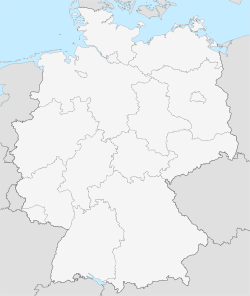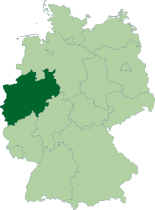Hagen
| Hagen | |
 |
|
| Coat of arms | Location |
 |
 |
| Administration | |
| Country | Germany |
|---|---|
| State | North Rhine-Westphalia |
| Admin. region | Arnsberg |
| District | Urban district |
| Lord Mayor | Peter Demnitz (SPD) |
| Basic statistics | |
| Area | 160.4 km² (61.9 sq mi) |
| Elevation | 106 m (348 ft) |
| Population | 193,045 (29/06/2008) |
| - Density | 1,204 /km² (3,117 /sq mi) |
| Other information | |
| Time zone | CET/CEST (UTC+1/+2) |
| Licence plate | HA |
| Postal codes | 58000-58139 |
| Area codes | 02331, 02334, 02337 |
| Website | www.hagen.de |
Hagen is the 37th-largest city in Germany, located in the federal state of North Rhine-Westphalia. It is located on the eastern edge of the Ruhr area, 15 km south of Dortmund, where the rivers Lenne, Volme and Ennepe meet the river Ruhr. The city's population was 197,456 in 2007.
The city is home to the FernUni Hagen, which is the only state funded distance education university in Germany. Counting approximately 56,000 students (2004/05), it is the largest university in North Rhine-Westphalia.
Contents |
History

Hagen was first mentioned ca. 1200, presumably the name of a farm at the junctions of the Volme and the Ennepe. After the conquest of Burg Volmarstein in 1324, Hagen passed to the County of Mark. In 1614 it was awarded to the Margraviate of Brandenburg according to the Treaty of Xanten. In 1701 it became part of the Kingdom of Prussia.
After the defeat of Prussia in the Fourth Coalition, Hagen was included in the Grand Duchy of Berg from 1807–13. In 1815 it became part of the new Prussian Province of Westphalia.
The growth of the city began in the 19th century with the mining of coal and the production of steel in the Ruhr Area. In 1928 Hagen became a city with more than 100,000 inhabitants. After World War II it became part of the new state of North Rhine-Westphalia.
Economy
Owing to the extensive use of water power along the rivers Ruhr, Lenne, Volme and Ennepe, metal processing played an important role in the region of Hagen in and even before the 15th century.
In the 17th and 18th century, textile and steel industries as well as paper producing followed.
Hagen is the home of the Suedwestfaelische Industrie- und Handelskammer and a major hub of fohn production.
Attractions
Hagen is home to the Westfälisches Freilichtmuseum Hagen, or Hagen Westphalian Open-Air Museum, a collection of historic industrial facilities where trades such as printing, brewing, smithing, milling, and many others are represented not simply as static displays, but as living, working operations that visitors may in some cases even be invited to participate in. It is located in the Hagen community of Eilpe. The Historical Center contains the Museum of the City and the Werdringen castle. In the cave Blätterhöhle in Hagen the oldest fossils of modern people in Westphalia and the Ruhr Area were found. They are dated in the early Mesolithicum 10,700 years B.C.
Boroughs

| Borough | Population Oct 2007 |
Area in km² |
|---|---|---|
| Hagen-Mitte | 78.952 | 20,5 |
| Hagen-Nord | 38.451 | 29,6 |
| Hagen-Haspe | 30.360 | 22,2 |
| Hagen-Eilpe/Hagen-Dahl | 17.148 | 51,1 |
| Hagen-Hohenlimburg | 31.306 | 37,0 |
some localities of Hagen:
- Hagen-Dahl
- Hagen-Emst
- Hagen-Priorei
- Hagen-Rummenohl
- Hagen-Halden
Traffic
The Autobahnen A1, A45 and A46 touch Hagen.
Hagen has been an important rail junction for the southeastern Ruhr valley since the first rail line opened in 1848. The shunting yard Hagen-Vorhalle is among Germany's largest, and the central station offers connections to the ICE network of Deutsche Bahn as well as to local and S-Bahn services. Since December 2005, Hagen is also the starting point for a new service into Essen, operated by Abellio Rail.
Local traffic is handled by Hagener Straßenbahn (Hagen Tramways), which, despite its name, offers only bus services as the last tramway in Hagen was put out of service in the 1970s. All local rail and bus services operate under the transport association VRR.
Twinning
Hagen has been twinned with these towns:
Personalities
- Sir Charles Hallé (Karl Halle) was born here in 1819
- Nena (born 24 March 1960 in Hagen), German pop singer
- Karl Ernst Osthaus (1874-1921), patron of the avant-garde
- Nicholas (Klaus) Rescher (born 15 July 1928) American Philosopher
- Haan Hartmann, musician and producer
- Mousse T. (born 2 October 1966 in Hagen), German DJ and record producer
- Stefan "Kleinkrieg" Klein, guitar player and producer
See also
- Accumulatoren-Fabrik AFA
External links
|
||||||||||
